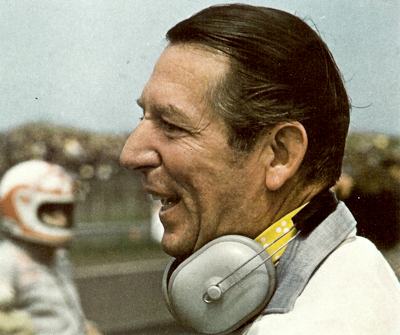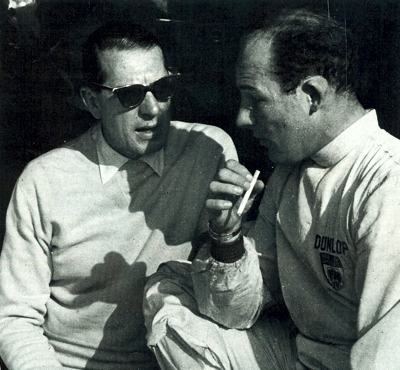Rob Walker Was Not A Good Racing Driver
Rob Walker was not a good racing driver. Instead he became an entrant whose superbly-prepared machines were driven by such well-known drivers as Tony Rolt, Reg Parnell, Stirling Moss, Tony Brooks, Maurice Trintignant,
Jack Brabham, Jo Bonnier,
Jo Siffert and Graham Hill. When the cost of running his own Grand Prix car became too much at the end of 1970, he helped sponsor the works Surtees team and became closely involved with the career of Mike Hailwood.
Robert Ramsay Campbell Walker was born in Rickmansworth, Hertfordshire, on 14 August 1917. At the age of seven, Rob was taken to watch the Boulogne Grand Prix and was immediately fascinated by motor racing. Four years later Rob and his elder brother were given a Hotchkiss-engined Morris Cowley and 'raced' 'it down the twisty three-quarter-mile-long family drive at their new Wiltshire home.
Before reaching the age of twenty Walker had owned more than twenty cars! With a supercharged Lea-Francis Ulster sports car reputed to have finished third in the Tourist Trophy Rob made his competition debut in the 1934 Lewes Speed Trials. Eventually his mother cried, 'No more sports cars!' and offered him a car of his choice so long as it was not a sports machine. He took her at her word and obtained a Rolls-Royce. But it was soon back to sports cars.
Type 135 Racing Delahaye
For his 21st birthday his mother bought a Delahaye and Rob bought another one, the ex-'B. Bira' Type 135 racing version. He raced at Brooklands, but confessed he was 'a terrible driver.' Soon he was talked into entering the Delahaye for other drivers, among them Arthur Dobson and 'B. Bira.' In 1939 Rob shared the Delahaye with Ian Connell at Le Mans, finishing eighth.
The Pippbrook Garage
During the war Walker was in the Fleet Air Arm and afterwards he became involved with several ventures. He ran a club on the Embankment and a travel agency before buying a garage, the Pippbrook Garage in Dorking, Surrey, in 1946. Rob no longer raced himself, but Pippbrook became the base for Walker's ever-changing team of racing cars. Guy Jason-Henry bought a half-share in Walker's Delahaye. In 1949 the Delahaye was driven by Jason-Henry and Tony Rolt in the first post-war Le Mans 24-hour race, who managed to run fifth until they were forced to retire. Rolt entered into a partnership with Walker, who was persuaded to buy two pre-war Delages and engage Freddie Dixon to tune them. The engines were brittle and after a spate of cracked blocks Walker installed an E-type ERA engine in one which became known as the ERA-Delage, and was campaigned with occasional succes by Rolt, Eric Thompson and Peter Walker until the end of 1952.
In 1953, when Formula Two assumed more importance than Formula One, Walker purchased a new Connaught A-type. Raced by Rolt, it won sixteen times and also enjoyed seven seconds and five thirds from 24 meetings in 1953 and 1954. Next year a new 2
½-liter Formula One Connaught B-type was purchased and when Rolt retired from racing at the end of 1955 it was conducted by Reg Parnell the following year. Parnell crashed badly at Crystal Palace, putting the car out of commission for several months and himself in hospital.
Brabham Pushes His Car To Sixth Place
At the end of 1956 Walker purchased a Formula Two Cooper Tar-Climax which Tony Brooks took to victory at Brands Hatch. Stirling Moss' ex-mechanic Alf Francis joined the team to prepare the racing machinery garaged at Pippbrook Garage for their owners. In 1957
Roy Salvadori and John Cooper approached Rob Walker. They had a theory that a Formula Two Cooper T43 powered by a 'stretched' version of the Coventry Climax FPF engine could prove a thorn in the side of current 2
½-liter Formula One Grand Prix machinery. Walker agreed to back the project, Coventry Climax enlarged an engine from 1475cc to 1962cc in time for the Monaco Grand Prix and
Jack Brabham was signed to drive the car. It is history now that Brabham was running a strong third in the closing stages, only for the fuel pump to fall off with five laps remaining. Undaunted, Brabham pushed the car to the finish line to claim a well earned sixth place.
 Rob Walker pictured during the 1973 Dutch Grand Prix.
Rob Walker pictured during the 1973 Dutch Grand Prix.
 Rob Walker talks with his most successful driver, Stirling Moss.
Rob Walker talks with his most successful driver, Stirling Moss. |
More promising performances led to Stirling Moss trying the car at Goodwood at the end of the year. Moss was impressed and asked to drive it in non-championship Formula One races in 1958; he was committed to Vanwall for Grands Prix. However, Vanwall were unprepared for the Argentine Grand Prix in January and Moss arranged for the little Walker Cooper to be flown out. No one gave it a chance against the works Ferraris and various Maseratis 250Fs, but Moss came through to win. It was Cooper's first Grand Prix victory, Walker's first, Coventry Climax's first and - more significant - the first World Championship race to be won by a rear-engined car.
Moss drove a Vanwall at Monaco, but Frenchman Maurice Trintignant handled the little 2-liter Cooper-and won! Other successes followed. Moss won the non-title Caen and Melbourne Grands Prix, while in Formula Two Moss won at Brands Hatch and Trintignant at Pau, Caen and Clermont-Ferrand. Moss asked to drive for Rob Walker full-time in 1959, by which time Coventry Climax had developed a full 2
½-liter engine for the Formula Two-based Cooper T45 chassis. It was a year spoilt by gearbox problems, but Moss won the Portuguese and Italian Grands Prix plus non-championship races conducted at Goodwood and Oulton Park.
In 1960 Stirling Moss found that his year-old Cooper TSI, even with slight modifications, was no match for the latest Cooper TS3 or Lotus 18. Cooper were not willing to supply a new car, but Lotus were. Moss won the Monaco Grand Prix in Rob Walker's new Lotus 18-Climax, but crashed heavily in practice for the Belgian Grand Prix and was out of action for several weeks. He won the United States Grand Prix, at Oulton Park and
Watkins Glen, plus the Tourist Trophy at Goodwood and a GT event at Nassau in a new Walker entry, a Ferrari 250GT co-owned by Dick Wilkins, but finished in Walker's familiar racing colours, St Andrew's Blue with a white stripe across the nose incorporating the racing roundel.
Rob Walker also arranged to enter a Formula Two Porsche for Moss in selected events. He won the South African Grand Prix and, at Aintree, Rob Walker-entered Lotuses provided Stirling Moss with two of his greatest wins in 1961 when he won the Monaco and German Grands Prix against much more powerful Ferrari opposition. He had also won other events at Warwick Farm and Modena and gained victory in the Oulton Park Gold Cup in the four-wheel-drive Ferguson Pqq-Climax which was entered by Walker. With the Ferrari Moss repeated his wins in the Tourist Trophy and at Nassau.
The Ferodo Gold Trophy
The 1962 season began well with Moss winning early-season races in Australia and New Zealand in Walker's Cooper or Lotus. In March, as a tribute to perhaps the greatest private entrant of all time, Rob Walker was awarded the prestigious Ferodo Gold Trophy. On Easter Monday Maurice Trintignant won the Pau Grand Prix, beating the Ferraris with Walker's four-cylinder Lotus 18/21-Climax. But that day of glory was tinged with disaster for Rob Walker: his star driver Stirling Moss crashed heavily at Goodwood in a Walker Lotus 18/24-Ciimax loaned to the UDT-Laystall team. Moss was destined never to race again.
For the remainder of the season Walker's new Lotus 24-Ciimax was raced without success by Trintignant. At the end of the year
Ricardo Rodriguez was engaged to race in the inaugural Mexican Grand Prix, but crashed and was killed during practice. Then Gary Hocking, the ex-motorcycle star, was killed when his Walker Lotus crashed practising for December's Natal Grand Prix. The two deaths plus the loss of Moss was enough for anyone to want to give up. But in 1963 Rob Walker decided to support Swedish driver
Jo Bonnier, using a 1962-model Cooper T60-Climax until a new T66 had been completed. A fourth at Enna and fifths at Syracuse, Silverstone, Karlskoga plus the Belgian and Mexican Grands Prix were mustered. Reliability was there, if not speed.
Next season a Brabham BT11-BRM was ordered, but before it arrived the old Cooper gave Bonnier a second at Snetterton and fourths at Syracuse and Aintree. At the end of the year Walker also bought an ex-works Brabham BT7-Climax and took on Swiss driver
Jo Siffert's Brabham BT11-BRM. Siffert was third in the United States Grand Prix. Bonnier and Siffert were regular team drivers for 1965. Siffert soon showed that a private team could still compete with the factory teams. He led at Syracuse, won the Mediterranean Grand Prix (where he beat
Jim Ciark's Lotus by 0.3 seconds) and the Swiss St Ursanne-Les Rangiers hillclimb and rounded off the year with fourth place in the Mexican Grand Prix.
For 1966, first year of the 3-liter Formula One, Walker bought a Cooper T81-Maserati, a large, heavy and somewhat underpowered machine. An ex-works 49-Ford was bought for 1968, but Siffert crashed it practising at Brands Hatch in March. A day later the wreck plus several valuable historic cars such as Walker's ex-Seaman Delage were destroyed. With no cars and no money Walker appeared ready to submit to enforced retirement. However, his brother-in-law gave him £15,000 and wealthy co-sponsor Jack Durlacher agreed to buy a replacement Lotus. An ex-works car was campaigned until a brand new machine was delivered in time for the British Grand Prix. Siffert drove superbly to win, notching up Walker's ninth, and last, World Championship Grand Prix victory.
The car was used for the remainder of 1968 and 1969, scoring several place results. Siffert moved to March in 1970, when Walker agreed to engage Graham Hill, who was recovering from serious injuries sustained in the 1969 United States Grand Prix. Driving determinedly, as ever, Hill rewarded Walker with several good placings in the now ageing Lotus 49, the team's new Lotus 72 not being delivered until the end of the year. Then Hill moved to Brabham and instead of running his own car Walker became a part-sponsor of the Surtees Formula One team. He became a friend and supporter of Mike Hailwood and when Hailwood moved from Surtees to the Yardley McLaren team in 1974 Walker was a common sight in the Yardley pit.
Switching to Journalism
Following Hailwood's retirement, Rob Walker's involvement with racing was as a journalist, enabling him to convey his great enthusiasm for, and knowledge of, the sport to the many readers of the American magazine Road and Track. Running parallel to the Rob Walker personal story is the saga of his group of garages. Walker's motor trading interests tended to be pushed into the background by his sporting pursuits, but from 1966 the garage group was built up by two brothers, Geoffrey and Graham Thomas, into a profitable empire specialising in foreign cars. From the early 1970s he contributed race reports to the American monthly magazine Road & Track, continuing long after he had given up direct racing team support. He passed away in 2002 at the age of 84.
